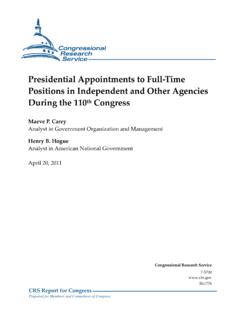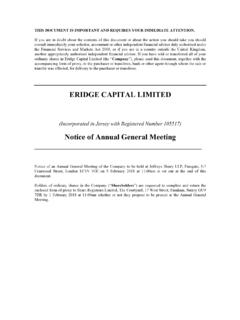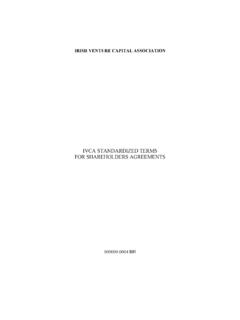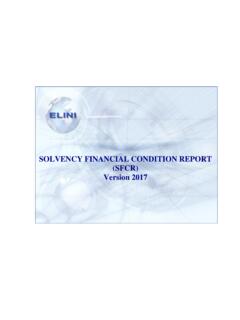Transcription of BEST PRACTICE GUIDELINES FOR THE APPOINTMENT OF …
1 DIRECTORS FORUMBEST PRACTICE GUIDELINES FOR THE APPOINTMENT OF DIRECTORSS eptember 20121. The Board is responsible for the long-term success of a company and its first responsibility is to provide direction and leadership within a framework of prudent and effective controls. The purpose of this paper is to promote best PRACTICE through practical GUIDELINES for the selection and nomination of directors in order to ensure that the Board consists of members with diverse skills and competencies, whilst ensuring a formal and transparent process for shareholders to recommend potential The purpose of this paper is not to reiterate the Code of Corporate Governance (the Code ), but rather to complement the Code and facilitate its There is no one-size-fits-all approach and each company must determine the process that suits its size and needs. All companies can apply these These Best PRACTICE GUIDELINES (the GUIDELINES ) should facilitate understanding of the roles of: Independent Directors; Non-Executive Directors; and Directors appointed by way of The GUIDELINES are organised in 6 essential steps for the APPOINTMENT of directors:- Needs analysis- Profile- Search- Selection- Nomination- A special resource pack designed to assist with the practical implementation of these GUIDELINES can be downloaded from the MIoD website ( ).
2 STEP 1 Needs AnalysisSTEP 5 NominationSTEP 6 AppointmentThose who havenot beennominatedDocumentsSubmittedMeet theselectedcandidatesMake nalrecommendationsto the BoardBoard ApprovalCommunicate tothe shareholdersBoard MinutesOrganise InductionLetter ofAppointmentElection by theshareholders at theAnnual MeetingDocumentedSkills, Experienceand AttributestableThose who have notpassed the selectionSTEP 2 Develop Pro leand CompetencySTEP 3 SearchSTEP 4 Selection- The Context- The size of the Board- Evaluation of current directors- Succession planning- Skills and Expertise required- Board diversity- Potential con icts of interestASSESS- Fellow directors- MIoD Directors Register- Business associates- Trade organisations- Professional search companies- Adverts in the media and on the company websitePOTENTIAL SOURCES- assess potential directors backgrounds, skills and experiences against the agreed pro le- check con icts of interest or independence issues- check number of directorshipsPRODUCE A SHORT LIST:YYYYNNNN- track records- references- veri cation checks DUE DILIGENCE.
3 Action StepProcessDecisionDocumentMultipleDocum entFlow LineStoresDataPrede nedProcessSortKEYSTEP 1 Needs AnalysisSTEP 5 NominationSTEP 6 AppointmentThose who havenot beennominatedDocumentsSubmittedMeet theselectedcandidatesMake nalrecommendationsto the BoardBoard ApprovalCommunicate tothe shareholdersBoard MinutesOrganise InductionLetter ofAppointmentElection by theshareholders at theAnnual MeetingDocumentedSkills, Experienceand AttributestableThose who have notpassed the selectionSTEP 2 Develop Pro leand CompetencySTEP 3 SearchSTEP 4 Selection- The Context- The size of the Board- Evaluation of current directors- Succession planning- Skills and Expertise required- Board diversity- Potential con icts of interestASSESS- Fellow directors- MIoD Directors Register- Business associates- Trade organisations- Professional search companies- Adverts in the media and on the company websitePOTENTIAL SOURCES- assess potential directors backgrounds, skills and experiences against the agreed pro le- check con icts of interest or independence issues- check number of directorshipsPRODUCE A SHORT LIST:YYYYNNNN- track records- references- veri cation checks DUE DILIGENCE:Action StepProcessDecisionDocumentMultipleDocum entFlow LineStoresDataPrede nedProcessSortKEY2 FLOW CHART3 Transparency and DisclosureA formal and transparent selection and nomination process is critical to gain the confidence and trust of all stakeholders, improve the understanding and efficiency of the processes in PRACTICE , and essential to improving Board particular, four important aspects should be disclosed: Ownership Structures, adequate information on the Nominated Candidates, the Nomination Process and finally the Elections are encouraged to provide greater transparency of the processes which the Board adopts in searching for and selecting new directors for the Board and to report to shareholders on the processes.
4 Such reporting should include the following:- details as to whether the company develops a board skills matrix or profile and uses this to identify any gaps in the skills and experience of the directors on the Board;- the process by which candidates are identified and selected including whether professional intermediaries are used to identify and/or assess candidates;- the steps taken to ensure that a diverse range of candidates is considered;- the factors taken into account in the selection and nomination processes; and- adequate information on the candidates including full background and relevant experience; and why the Board believes they are suitable timing of information is important as it should be disclosed prior to the Shareholders Meeting, preferably with the Notice of the Shareholders Meeting, giving the shareholders enough time to review the abilities and suitability of candidates. If, between Shareholders Meetings, a director has been appointed by the Board to fill a casual vacancy, the shareholders should be advised immediately, with full details of the process of from sending the maximum information with the Notice of the Shareholders Meeting, companies can also use their websites for full information and disclosure as well as full disclosure in the company s Annual NEEDS The ContextThe starting point for a Board in the recruitment of new directors is a review of the company s strategy and business.
5 For example, a company looking to expand into new sectors may want someone with experience in mergers and acquisitions. It is important to review the context for each new APPOINTMENT as strategy Size of the The company s constitution normally sets out the size of the Board. The number of Board members depends on the size and complexity of the organisation, the type of business, industry and the operating Too few or too many directors may pose problems for effective decision making. A Board with too few members may not allow the company to benefit from an appropriate mix of skills and experience. A larger Board, on the other hand, is typically more difficult to manage. It can make consensus-building both time consuming and difficult, with a tendency to form cliques and core groups and there is a danger of loss of individual The following factors should be taken into consideration: ensuring productive and constructive discussions with different perspectives; size of the quorum for making prompt decisions; enough members to easily manage the work load of the Board; the effective composition of Board committees composed primarily of and chaired by independent directors; engaging all Board members in a meaningful activity so they remain motivated and involved; the need for a separate Chairman and CEO; at least 2 executives on the Board; at least 2 independent directors.
6 Ideally one third of the Board should be composed of independent directors; the right balance between executive and non-executive directors and independent directors so that no individual or small group of individuals can dominate decision making; and the appropriate mix of skills or specific experience Conflicts of When selecting directors, the Board should be conscious of shareholder and public perceptions and seek to avoid situations where there might be a perceived or real conflict of interest. Candidates who have conflicting interests to the company should not be short Numerous studies show that diversity in Board demographics provides companies with competitive advantage. Diversity should be factored into the equation when considering the selection and nomination of a new director. While many directors feel that collegiality might contribute to a more collaborative working environment, it can also be an obstacle to increasing diversity and its attendant strengths.
7 These strengths include bringing widely varied perspectives and experiences to complex issues of strategy and performance monitoring and the greater likelihood of the Board addressing the broad social impact of many business decisions. Selection should be made on merit against objective criteria, while taking into consideration age, gender and alternative When diversity has not typically been a feature of a Board, it is now best PRACTICE to:- establish diversity policies;- report annually on diversity policies; and- require diversity to be considered when evaluating Board Skills and An effective Board has a balance of well-chosen, competent directors who, with the Chairman s leadership and guidance, form a cohesive group to shape the company s destiny, safeguard its interests, and ensure its profitable The skills and expertise that may be valuable to a company can be varied and will likely depend on the industry and the company s particular circumstances. Theneeds and skills required will change from one Board to the next but there are a few common elements which should be borne in mind to create an effective An effective Board has the right mix of director skills, experience and attributes and Boards need to widen their search parameters for directors, while taking into consideration the geographical location of the directors and other practical appointed by way of RecommendationRegardless of who nominates a director, directors must serve the Board in their individual capacity, consistent with the responsibilities of a director, and not as the representative of any particular shareholder.
8 The fundamental duty of any director is to act in the best interests of the company that he/she serves. All candidates, including those recommended by shareholders/stakeholders, should be considered using the process described in these of Non-Executive DirectorsA Non-Executive Director is not an employee and is not involved in the operational aspects of the company, rather he / she is involved in planning and policymaking and brings independent judgment, outside experience and objectivity on all issues which come before the Board. Over and above their normal directors duties, Non-Executive Directors are expected to monitor and challenge the performance of the Executive Directors and the Management, and to take a determined stand in the interests of the company and its stakeholders. Non-Executive Directors should acquire and maintain a sufficiently detailed knowledge of the company s business activities and on-going performance to enable them to make informed decisions on the issues before the Board.
9 At the same time, they should recognise the division between the Board and Management and ordinarily not become involved in management issues or in managing the implementation of Board wisdom and good judgmentFinancial literacy; ability to read and understand a financial statementSpecialised professional skills eg. Accounting, Finance, HR, Legal, ICT, MarketingAn understanding of key technologiesDirector education a clear understanding of the duties of a director and knowledge of the interpersonal skills and the ability to communicate clearlyDecision maker exploring options and choosing those that have the greatest benefit to the organisation and its performanceRisk Management Interpersonal sensitivity a willingness to keep an open mind and recognise other perspectivesAbility to mentor other directorsStrong ability to represent the company to stakeholdersAgility to move from advisor to challenger as well as being a strong supporting voice when neededAdvisory skillsEXPERIENCES pecialist knowledge in a specific areaA detailed knowledge of the industry / relevant industry experienceExpertise on global issuesExperience in other industries using experience gained in one industry for the benefit of a company in another industryHigh visibility in the fieldLeadership and management experience.
10 Especially in related businessesInternational experiencePersonal networks and external contactsATTRIBUTESH ighest personal and professional ethical standards and honestyIntegrity, independence and free of conflicts of interestAn enquiring and independent mindWillingness and commitment to devote the required amount of time to carrying out the duties and responsibilities of Board membership, including time to gain knowledge of the industry, to prepare for Board meetings, and to participate in to improving the business, its continued well-being and making a difference. Commitment to making this role a significant priority, not serving just for the money or for personal to represent the best interests of all stakeholders and objectively appraise board and management performanceCritical analysis and judgmentVision, imagination and foresightStrategic perspective, able to identify opportunities and threatsInnovator - a willingness to challenge management and challenge assumptions, stimulate board discussion with new, alternative insights and ideasCuriosity - possessing an intellectual curiosity about the company and the trends impacting itMotivation drive and energy to set and achieve clear objectives and make an impactConscientiousness - clear personal commitmentEngagement - full participation and proactive as a Board memberCourage - willingness to deal with tough issuesMaturity and discipline to know and maintain the fine line between governance and managerial Below is a non-exhaustive list of the mix of skills, experience.





